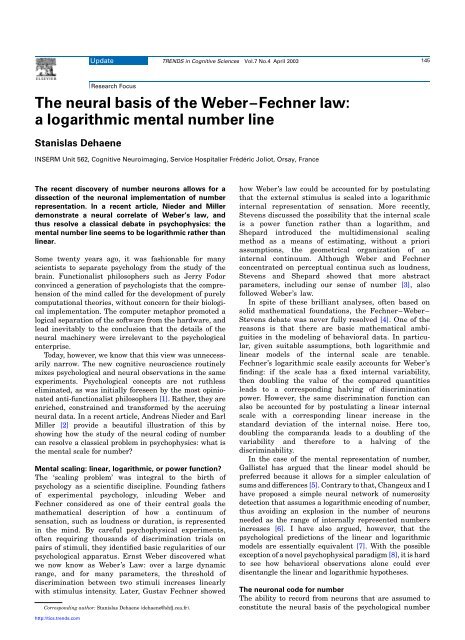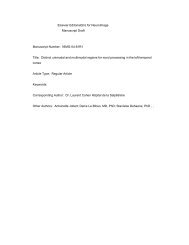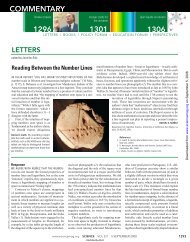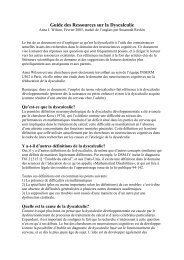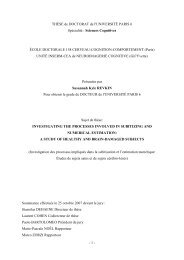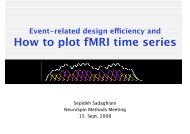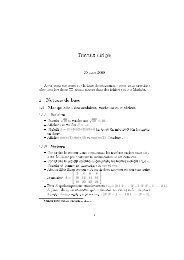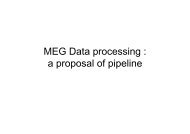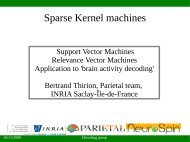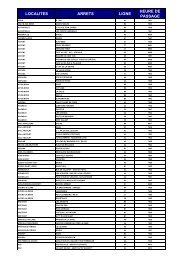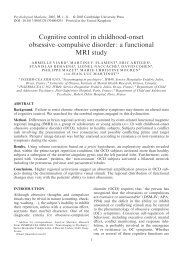The neural basis of the Weber–Fechner law: a logarithmic mental ...
The neural basis of the Weber–Fechner law: a logarithmic mental ...
The neural basis of the Weber–Fechner law: a logarithmic mental ...
You also want an ePaper? Increase the reach of your titles
YUMPU automatically turns print PDFs into web optimized ePapers that Google loves.
Update TRENDS in Cognitive Sciences Vol.7 No.4 April 2003 145<br />
| Research Focus<br />
<strong>The</strong> <strong>neural</strong> <strong>basis</strong> <strong>of</strong> <strong>the</strong> <strong>Weber–Fechner</strong> <strong>law</strong>:<br />
a <strong>logarithmic</strong> <strong>mental</strong> number line<br />
Stanislas Dehaene<br />
INSERM Unit 562, Cognitive Neuroimaging, Service Hospitalier Frédéric Joliot, Orsay, France<br />
<strong>The</strong> recent discovery <strong>of</strong> number neurons allows for a<br />
dissection <strong>of</strong> <strong>the</strong> neuronal implementation <strong>of</strong> number<br />
representation. In a recent article, Nieder and Miller<br />
demonstrate a <strong>neural</strong> correlate <strong>of</strong> Weber’s <strong>law</strong>, and<br />
thus resolve a classical debate in psychophysics: <strong>the</strong><br />
<strong>mental</strong> number line seems to be <strong>logarithmic</strong> ra<strong>the</strong>r than<br />
linear.<br />
Some twenty years ago, it was fashionable for many<br />
scientists to separate psychology from <strong>the</strong> study <strong>of</strong> <strong>the</strong><br />
brain. Functionalist philosophers such as Jerry Fodor<br />
convinced a generation <strong>of</strong> psychologists that <strong>the</strong> comprehension<br />
<strong>of</strong> <strong>the</strong> mind called for <strong>the</strong> development <strong>of</strong> purely<br />
computational <strong>the</strong>ories, without concern for <strong>the</strong>ir biological<br />
implementation. <strong>The</strong> computer metaphor promoted a<br />
logical separation <strong>of</strong> <strong>the</strong> s<strong>of</strong>tware from <strong>the</strong> hardware, and<br />
lead inevitably to <strong>the</strong> conclusion that <strong>the</strong> details <strong>of</strong> <strong>the</strong><br />
<strong>neural</strong> machinery were irrelevant to <strong>the</strong> psychological<br />
enterprise.<br />
Today, however, we know that this view was unnecessarily<br />
narrow. <strong>The</strong> new cognitive neuroscience routinely<br />
mixes psychological and <strong>neural</strong> observations in <strong>the</strong> same<br />
experiments. Psychological concepts are not ruthless<br />
eliminated, as was initially foreseen by <strong>the</strong> most opinionated<br />
anti-functionalist philosophers [1]. Ra<strong>the</strong>r, <strong>the</strong>y are<br />
enriched, constrained and transformed by <strong>the</strong> accruing<br />
<strong>neural</strong> data. In a recent article, Andreas Nieder and Earl<br />
Miller [2] provide a beautiful illustration <strong>of</strong> this by<br />
showing how <strong>the</strong> study <strong>of</strong> <strong>the</strong> <strong>neural</strong> coding <strong>of</strong> number<br />
can resolve a classical problem in psychophysics: what is<br />
<strong>the</strong> <strong>mental</strong> scale for number?<br />
Mental scaling: linear, <strong>logarithmic</strong>, or power function?<br />
<strong>The</strong> ‘scaling problem’ was integral to <strong>the</strong> birth <strong>of</strong><br />
psychology as a scientific discipline. Founding fa<strong>the</strong>rs<br />
<strong>of</strong> experi<strong>mental</strong> psychology, inlcuding Weber and<br />
Fechner considered as one <strong>of</strong> <strong>the</strong>ir central goals <strong>the</strong><br />
ma<strong>the</strong>matical description <strong>of</strong> how a continuum <strong>of</strong><br />
sensation, such as loudness or duration, is represented<br />
in <strong>the</strong> mind. By careful psychophysical experiments,<br />
<strong>of</strong>ten requiring thousands <strong>of</strong> discrimination trials on<br />
pairs <strong>of</strong> stimuli, <strong>the</strong>y identified basic regularities <strong>of</strong> our<br />
psychological apparatus. Ernst Weber discovered what<br />
we now know as Weber’s Law: over a large dynamic<br />
range, and for many parameters, <strong>the</strong> threshold <strong>of</strong><br />
discrimination between two stimuli increases linearly<br />
with stimulus intensity. Later, Gustav Fechner showed<br />
Corresponding author: Stanislas Dehaene (dehaene@shfj.cea.fr).<br />
how Weber’s <strong>law</strong> could be accounted for by postulating<br />
that <strong>the</strong> external stimulus is scaled into a <strong>logarithmic</strong><br />
internal representation <strong>of</strong> sensation. More recently,<br />
Stevens discussed <strong>the</strong> possibility that <strong>the</strong> internal scale<br />
is a power function ra<strong>the</strong>r than a logarithm, and<br />
Shepard introduced <strong>the</strong> multidimensional scaling<br />
method as a means <strong>of</strong> estimating, without a priori<br />
assumptions, <strong>the</strong> geometrical organization <strong>of</strong> an<br />
internal continuum. Although Weber and Fechner<br />
concentrated on perceptual continua such as loudness,<br />
Stevens and Shepard showed that more abstract<br />
parameters, including our sense <strong>of</strong> number [3], also<br />
followed Weber’s <strong>law</strong>.<br />
In spite <strong>of</strong> <strong>the</strong>se brilliant analyses, <strong>of</strong>ten based on<br />
solid ma<strong>the</strong>matical foundations, <strong>the</strong> Fechner–Weber–<br />
Stevens debate was never fully resolved [4]. One<strong>of</strong><strong>the</strong><br />
reasons is that <strong>the</strong>re are basic ma<strong>the</strong>matical ambiguities<br />
in <strong>the</strong> modeling <strong>of</strong> behavioral data. In particular,<br />
given suitable assumptions, both <strong>logarithmic</strong> and<br />
linear models <strong>of</strong> <strong>the</strong> internal scale are tenable.<br />
Fechner’s <strong>logarithmic</strong> scale easily accounts for Weber’s<br />
finding: if <strong>the</strong> scale has a fixed internal variability,<br />
<strong>the</strong>n doubling <strong>the</strong> value <strong>of</strong> <strong>the</strong> compared quantities<br />
leads to a corresponding halving <strong>of</strong> discrimination<br />
power. However, <strong>the</strong> same discrimination function can<br />
also be accounted for by postulating a linear internal<br />
scale with a corresponding linear increase in <strong>the</strong><br />
standard deviation <strong>of</strong> <strong>the</strong> internal noise. Here too,<br />
doubling <strong>the</strong> comparanda leads to a doubling <strong>of</strong> <strong>the</strong><br />
variability and <strong>the</strong>refore to a halving <strong>of</strong> <strong>the</strong><br />
discriminability.<br />
In <strong>the</strong> case <strong>of</strong> <strong>the</strong> <strong>mental</strong> representation <strong>of</strong> number,<br />
Gallistel has argued that <strong>the</strong> linear model should be<br />
preferred because it allows for a simpler calculation <strong>of</strong><br />
sums and differences [5]. Contrary to that, Changeux and I<br />
have proposed a simple <strong>neural</strong> network <strong>of</strong> numerosity<br />
detection that assumes a <strong>logarithmic</strong> encoding <strong>of</strong> number,<br />
thus avoiding an explosion in <strong>the</strong> number <strong>of</strong> neurons<br />
needed as <strong>the</strong> range <strong>of</strong> internally represented numbers<br />
increases [6]. I have also argued, however, that <strong>the</strong><br />
psychological predictions <strong>of</strong> <strong>the</strong> linear and <strong>logarithmic</strong><br />
models are essentially equivalent [7]. With <strong>the</strong> possible<br />
exception <strong>of</strong> a novel psychophysical paradigm [8], it is hard<br />
to see how behavioral observations alone could ever<br />
disentangle <strong>the</strong> linear and <strong>logarithmic</strong> hypo<strong>the</strong>ses.<br />
<strong>The</strong> neuronal code for number<br />
<strong>The</strong> ability to record from neurons that are assumed to<br />
constitute <strong>the</strong> <strong>neural</strong> <strong>basis</strong> <strong>of</strong> <strong>the</strong> psychological number<br />
http://tics.trends.com
146<br />
Update TRENDS in Cognitive Sciences Vol.7 No.4 April 2003<br />
(a) Anatomy<br />
Performance<br />
(% same as sample)<br />
100<br />
80<br />
60<br />
40<br />
20<br />
0<br />
Principal<br />
sulcus<br />
Monkey T<br />
Monkey P<br />
Average<br />
Arcuate<br />
sulcus<br />
(b) Number discrimination performance<br />
1 5 10<br />
Number <strong>of</strong> items (log scale)<br />
(c) Neural tuning curves<br />
Normalized response (%)<br />
100<br />
75<br />
50<br />
25<br />
0<br />
100<br />
75<br />
50<br />
25<br />
0<br />
00<br />
75<br />
50<br />
25<br />
0<br />
100<br />
75<br />
50<br />
25<br />
0<br />
100<br />
75<br />
50<br />
25<br />
0<br />
1 2 3 4 5<br />
Number <strong>of</strong> items<br />
(log scale)<br />
1<br />
2<br />
3<br />
4<br />
5<br />
TRENDS in Cognitive Sciences<br />
Fig. 1. Evidence for <strong>logarithmic</strong> coding <strong>of</strong> number in <strong>the</strong> monkey brain. (a) <strong>The</strong> anatomical location in monkey prefrontal cortex where Nieder and Miller recorded number<br />
neurons. In <strong>the</strong>ir experiments, monkeys were presented with a first set <strong>of</strong> dots, which <strong>the</strong>y were <strong>the</strong>n asked to discriminate from a second set <strong>of</strong> dots. (b) <strong>The</strong> percentage <strong>of</strong><br />
trials on which <strong>the</strong>y responded ‘same’ is plotted as a function <strong>of</strong> <strong>the</strong> second number (abscissa) for different values <strong>of</strong> <strong>the</strong> first number, which ranged from 2–6 during behavioral<br />
testing (color <strong>of</strong> plot). Performance decreased smoothly with <strong>the</strong> distance between <strong>the</strong> two numbers (i.e. <strong>the</strong> peak occurs when <strong>the</strong> two numbers are <strong>the</strong> same). This<br />
distance effect assumed a Gaussian shape when plotted on a <strong>logarithmic</strong> scale. (c) So did <strong>the</strong> tuning curves <strong>of</strong> individual number neurons (shown for 1–5).<br />
scale now brings direct physiological evidence to bear on<br />
this issue. In <strong>the</strong> early days <strong>of</strong> neurophysiology, a few<br />
neurons that encoded number were reported in <strong>the</strong><br />
association cortex <strong>of</strong> <strong>the</strong> cat [9], although this initial<br />
discovery was quickly forgotten. In 2002, however, two<br />
papers, one recording in parietal cortex and <strong>the</strong> o<strong>the</strong>r in<br />
prefrontal cortex, reported <strong>the</strong> observation <strong>of</strong> neurons<br />
whose firing rate was tuned to a specific numerosity<br />
[10,11]. A given neuron, for instance, might respond<br />
optimally to three visual objects, a little less to displays<br />
or two or four objects, and not at all to displays <strong>of</strong> one or five<br />
objects. This <strong>of</strong>fered a unique opportunity to examine <strong>the</strong><br />
<strong>neural</strong> code for an abstract psychological continuum.<br />
As noted by Nieder and Miller, it was particularly<br />
interesting to investigate <strong>the</strong> <strong>neural</strong> <strong>basis</strong> <strong>of</strong> Weber’s <strong>law</strong><br />
with an abstract dimension such as number. For parameters<br />
that are more closely dependent on sensory<br />
physiology, such as loudness, weight or brightness, <strong>the</strong>re<br />
is <strong>of</strong>ten evidence that <strong>the</strong> stimulus compression occurs at a<br />
peripheral sensory level. In <strong>the</strong> case <strong>of</strong> number, however,<br />
<strong>the</strong>re are no obvious limitations in our ability to perceive<br />
multiple objects or sounds. Fur<strong>the</strong>rmore, in human<br />
subjects, Weber’s <strong>law</strong> is even observed with symbolic<br />
stimuli such as Arabic digits [3,12]. Thus, it is likely that<br />
Weber’s <strong>law</strong> for numbers is determined solely by <strong>the</strong><br />
internal organization <strong>of</strong> cortical representations.<br />
In <strong>the</strong>ir paper, Nieder and Miller analyzed in minute<br />
detail <strong>the</strong> behavioral and <strong>neural</strong> response curves <strong>of</strong> two<br />
monkeys, which had been engaged in a task <strong>of</strong> discriminating<br />
<strong>the</strong> numerosity <strong>of</strong> two visually presented sets [2]<br />
(Fig. 1). <strong>The</strong>y found clear evidence for Weber’s <strong>law</strong>. Both<br />
animals showed a linear increase in <strong>the</strong>ir discrimination<br />
thresholds as <strong>the</strong> numerosity increased. Fur<strong>the</strong>rmore, <strong>the</strong><br />
data were sufficiently regular to allow for a detailed<br />
analysis <strong>of</strong> <strong>the</strong> exact shape <strong>of</strong> <strong>the</strong> response distributions.<br />
When plotted on a linear scale, both behavioral and <strong>neural</strong><br />
tuning curves were asymmetrical, and assumed a different<br />
width for each number. Both sets <strong>of</strong> curves, however,<br />
became simpler when plotted on a <strong>logarithmic</strong> scale: <strong>the</strong>y<br />
were fitted by a Gaussian with a fixed variance across <strong>the</strong><br />
entire range <strong>of</strong> numbers tested (Fig. 1b,c). Thus, <strong>the</strong> <strong>neural</strong><br />
code for number can be described in a more parsimonious<br />
way by a <strong>logarithmic</strong> than by a linear scale.<br />
It should be stressed that this form <strong>of</strong> internal<br />
representation was not imposed by <strong>the</strong> training scheme<br />
<strong>the</strong> monkeys had. Training was based solely on <strong>the</strong><br />
http://tics.trends.com
Update TRENDS in Cognitive Sciences Vol.7 No.4 April 2003 147<br />
numbers 1 to 5, which were presented with roughly equal<br />
frequency. <strong>The</strong> optimal coding scheme would <strong>the</strong>refore<br />
have been a linear code with an exact encoding <strong>of</strong> each<br />
number 1, 2, 3, 4 and 5. <strong>The</strong> fact that <strong>the</strong> monkeys could<br />
not help but encode <strong>the</strong> numerosities on an approximate<br />
compressed scale confirms that this approximation mode is<br />
<strong>the</strong> natural way that number is encoded in a brain without<br />
language [13].<br />
Future prospects<br />
<strong>The</strong> monkey data <strong>of</strong> Nieder and Miller are just a first stab<br />
at <strong>the</strong> problem from <strong>the</strong> neurophysiological standpoint,<br />
and do not fully resolve <strong>the</strong> Fechner–Weber–Stevens<br />
debate yet. When Nieder and Miller fitted <strong>the</strong>ir data with a<br />
power function, <strong>the</strong>y obtained only a slightly worse fit than<br />
that with <strong>the</strong> <strong>logarithmic</strong> scale. To discriminate <strong>the</strong> power<br />
and <strong>the</strong> <strong>logarithmic</strong> functions in future experiments, it will<br />
be important to increase <strong>the</strong> range <strong>of</strong> numbers tested. We<br />
know from behavioral paradigms that, once trained with<br />
small numerosities, monkeys generalize to larger numbers<br />
up to 10 or more [14]. This is ano<strong>the</strong>r pro<strong>of</strong> that <strong>the</strong><br />
numerical ability <strong>of</strong> animals is not merely inculcated in<br />
<strong>the</strong>m by laboratory training, but is inherent in <strong>the</strong>ir<br />
<strong>mental</strong> toolkit [12]. It is already remarkable that one can<br />
discriminate linear and <strong>logarithmic</strong> coding schemes with a<br />
range <strong>of</strong> numbers as small as 1 to 5. By testing <strong>the</strong> neurons<br />
with a greater range <strong>of</strong> numbers, it should be easier to see<br />
if <strong>the</strong> small advantage <strong>of</strong> <strong>the</strong> <strong>logarithmic</strong> fit over <strong>the</strong> power<br />
function fit found over <strong>the</strong> range 1 to 5 will continue to hold<br />
with larger numerosities.<br />
Overall, Nieder and Miller’s recordings confirm<br />
Fechner’s intuitions <strong>of</strong> 130 years ago. <strong>The</strong> <strong>neural</strong> representation<br />
<strong>of</strong> number is comparable to <strong>the</strong> slide rule that<br />
some <strong>of</strong> us learned to use before <strong>the</strong> advent <strong>of</strong> electronic<br />
calculators, which was also graduated with a <strong>logarithmic</strong><br />
scale. <strong>The</strong> advantages <strong>of</strong> this instrument were two-fold.<br />
First, it was compact enough to allow <strong>the</strong> processing <strong>of</strong><br />
arbitrarily large numbers with a pocket-sized device.<br />
Second, it ensured an accuracy proportional to <strong>the</strong> size <strong>of</strong><br />
<strong>the</strong> numbers involved, something that was pertinent for<br />
real-life engineering applications. Perhaps <strong>the</strong> very same<br />
reasons can explain why nature selected an ‘internal slide<br />
rule’ as its most efficient way <strong>of</strong> doing <strong>mental</strong> arithmetic.<br />
References<br />
1 Churchland, P.S. (1986) Neurophilosophy: Toward a Unified Science <strong>of</strong><br />
<strong>the</strong> Mind/Brain, MIT Press<br />
2 Nieder, A. and Miller, E.K. (2003) Coding <strong>of</strong> cognitive magnitude:<br />
Compressed scaling <strong>of</strong> numerical information in <strong>the</strong> primate prefrontal<br />
cortex. Neuron 37, 149–157<br />
3 Shepard, R.N. et al. (1975) <strong>The</strong> internal representation <strong>of</strong> numbers.<br />
Cogn. Psychol. 7, 82–138<br />
4 Krueger, L.E. (1989) Reconciling Fechner and Stevens: Toward a<br />
unified psychophysical <strong>law</strong>. Behav. Brain Sci. 12, 251–267<br />
5 Gallistel, C.R. and Gelman, R. (1992) Preverbal and verbal counting<br />
and computation. Cognition 44, 43–74<br />
6 Dehaene, S. and Changeux, J.P. (1993) Development <strong>of</strong> elementary<br />
numerical abilities: A neuronal model. J. Cogn. Neurosci. 5, 390–407<br />
7 Dehaene, S. (2001) Subtracting pigeons: <strong>logarithmic</strong> or linear?<br />
Psychol. Sci. 12, 244–246<br />
8 Gorea, A. and Sagi, D. (2001) Disentangling signal from noise in visual<br />
contrast discrimination. Nat. Neurosci. 4, 1146–1150<br />
9 Thompson, R.F. et al. (1970) Number coding in association cortex <strong>of</strong> <strong>the</strong><br />
cat. Science 168, 271–273<br />
10 Nieder, A. et al. (2002) Representation <strong>of</strong> <strong>the</strong> quantity <strong>of</strong> visual items in<br />
<strong>the</strong> primate prefrontal cortex. Science 297, 1708–1711<br />
11 Sawamura, H. et al. (2002) Numerical representation for action in <strong>the</strong><br />
parietal cortex <strong>of</strong> <strong>the</strong> monkey. Nature 415, 918–922<br />
12 Dehaene, S. (1997) <strong>The</strong> Number Sense, Oxford University Press<br />
13 Dehaene, S. et al. (1999) Sources <strong>of</strong> ma<strong>the</strong>matical thinking: behavioral<br />
and brain-imaging evidence. Science 284, 970–974<br />
14 Brannon, E.M. and Terrace, H.S. (2000) Representation <strong>of</strong> <strong>the</strong><br />
numerosities 1–9 by rhesus macaques (Macaca mulatta). J. Exp.<br />
Psychol. Anim. Behav. Process. 26, 31–49<br />
1364-6613/03/$ - see front matter q 2003 Elsevier Science Ltd. All rights reserved.<br />
doi:10.1016/S1364-6613(03)00055-X<br />
Structure and pragmatics in informal argument:<br />
circularity and question-begging<br />
Sarah K. Brem<br />
Division <strong>of</strong> Psychology in Education, Mail Code 0611, Arizona State University, Tempe, AZ 85287-0611, USA<br />
Most everyday arguments are informal, as contrasted<br />
with <strong>the</strong> formal arguments <strong>of</strong> logic and ma<strong>the</strong>matics.<br />
Whereas formal argument is well understood, <strong>the</strong> nature<br />
<strong>of</strong> informal argument is more elusive. A recent study by<br />
Rips (2002) provides fur<strong>the</strong>r evidence regarding <strong>the</strong> roles<br />
<strong>of</strong> structure and pragmatics in informal argument.<br />
An exemplar <strong>of</strong> formal argument is <strong>the</strong> syllogism: Socrates<br />
is a man, all men are mortal, <strong>the</strong>refore we may conclude<br />
that Socrates is mortal. Formal argument is deductive;<br />
Corresponding author: Sarah K. Brem (sarah.brem@asu.edu).<br />
given that <strong>the</strong> premises are true, any conclusion made<br />
without violating any rules <strong>of</strong> logic is also necessarily true.<br />
Formal argument plays an essential role in areas such as<br />
ma<strong>the</strong>matics and logic [1,2]. Informal arguments, however,<br />
are based on induction and marked by uncertainty. All<br />
propositions about <strong>the</strong> world are inherently imperfect; we<br />
believe that <strong>the</strong> sun will rise tomorrow, but we can as easily<br />
conceive <strong>of</strong> <strong>the</strong> alternative [3]. Countless events could turn us<br />
onourhead,literally andmetaphorically.No<strong>the</strong>ory about <strong>the</strong><br />
world can ever be fully proven or refuted; all are built upon<br />
countless unstated assumptions [4]. When we argue about<br />
whomtovoteforor<strong>the</strong>bestrecycling policy,<strong>the</strong>imperfections<br />
http://tics.trends.com


